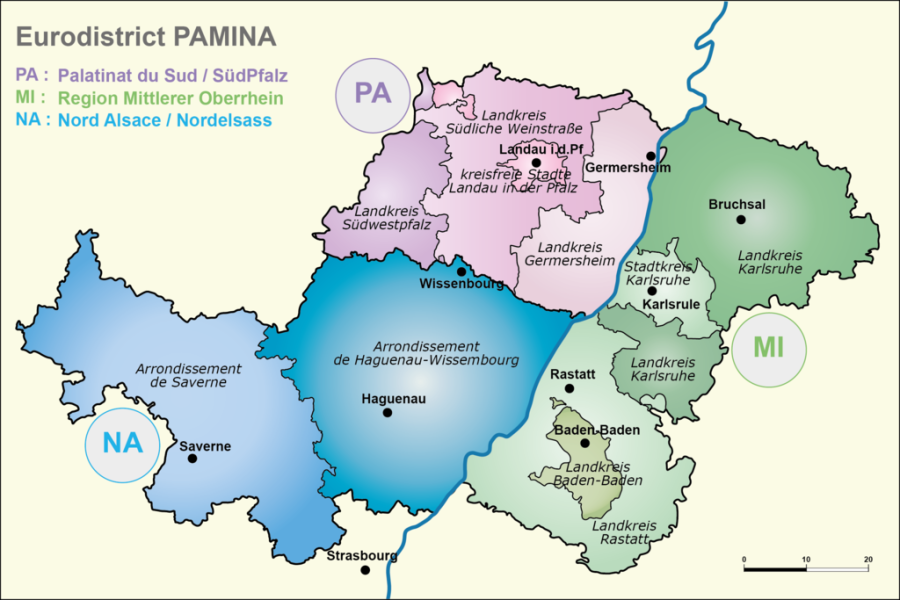In this article, we explore the actions and interventions of a historic EGTC, the Eurodistrict Pamina. The Eurodistrict engulfs an area with a total population of 1.7 million inhabitants which is also considered as one of the areas of Europe with the biggest cross border flows of people. Amongst the people commuting across the border on a daily basis are the cross-border workers of the area with the region striving for ever more integration of its labour markets.
WHAT
The PAMINA Eurodistrict has remained active in the area of labour market integration throughout its 40 years long history. The region’s strategy of bringing together the qualified actors and stakeholders in a number of efforts and projects to improve coherence between measures, funding policies and assist the integration of the labour markets has greatly impacted the integration efforts of the cross-border labour markets of Germany and France. The strategy has mainly been expressed in actions and initiatives that primarily revolved around the following tasks:
- Offering Information to cross border workers and commuters.
- Hosting and facilitating a series of cross border matching processes. These include info days, job dating, mentorships and apprentices across the border.
- Skills demands and supply assessment actions.
- Implementing supporting projects for special target groups (Youth, 45+ etc)
Examples of this include projects launched through the support of the INTERREG V A Upper Rhine Programme such as the vocational education and training project for the Alsace region and the more recent Regional LAB. The Regional LAB aims to boost cross-border mobility in terms of the labour market by encouraging and informing young people to seek vocational education and employment on the other side of the border. The project was initiated in January 2023 and is expected to last until 2026. It includes several measures and actions such as:
- Thematic labs connecting stakeholders
- The establishment of Regio Lab ambassadors to raise awareness
- Participation in job fairs with offers for cross border work
- Digital tools for the establishment of exchange forums for teachers and companies
- Teacher training
- Funding for small group or individual trips for workers across the border
- A pilot that will trial a multi-year cross-border vocational orientation program for vocational schools
- A series of public events to present and discuss the outputs of the project
WHO
Eurodistrict PAMINA was founded in 1988 with the signing of the Weißenburg Declaration of Intent. It is characterized by rising unemployment on the French side and a shortage of skilled workers on the German side. The Eurodistrict PAMINA has been actively engaged in improving the employment and labour market situation of its 1.7 million citizens since 1991 when the cooperation area first offered an innovative instrument for the labor market with the launch of an information and advisory office for cross-border workers (INFOBEST). This was an effort which was replicated by numerous other cooperation areas in the coming years. Eurodistrict PAMINA participates in the Regio Labs project as an associate partner and is thus involved in various measures which concern the territorial dimension of its area. The Eurodistrict has access to the local networks of employment and education/ training stakeholders and has an important cross-border interchange function between the Upper Rhine and the local level.

WHERE
Eurodistrict PAMINA is a cross border cooperation institution covering 2 countries’ sub-regions: the southern Palatinate, the Middle Upper Rhine (Germany) and North Alsace (France).It is named after the three rivers that flow through the region: the Rhine (PA), the Moselle (MI), and the Nahe (NA). The Pamina region encompasses parts of the following administrative divisions: Germany: State of Baden-Württemberg: Including the districts of Karlsruhe, Rastatt, and Germersheim. France: Region of Grand Est: Including the departments of Bas-Rhin and Haut-Rhin. Region of Alsace: Including the departments of Bas-Rhin and Haut-Rhin. Region of Lorraine: Including the department of Moselle.
HOW
Both ESF and INTERREG funds are available for employment-related issues within the Eurodistrict. The Regio Labs project is budgeted at just above 2 mln Euros with 1.2 being co-financed by INTERREG Upper Rhine.
RESULTS
The Eurodistrict Pamina has been quite active on the front of integrating the cross-border labour markets of the area since its inception. On a yearly basis, it handles and supports over 2000 individual queries that are labour market related, it has informed and coached several hundred jobseekers, it has provided additional training opportunities for hundreds of 45+ workers and it has established the PAMINA Business Club in 1998 which is still active today, and brings together relevant stakeholders and businesses. A direct consequence of these efforts has also been the establishment of several German employers, with factories, in the French city of Haguenau (e.g.SEW-Usocome and SIEMENS). This is the very relevant and successful heritage that currently implemented projects such as the Regional Labs seek to continue. Overall the Pamina Euroregion constitutes a long standing good example of the effective promotion of cross border labour market integration.
If you wish to find out more about the Eurodistrict’s successful initiatives you can visit the following links:
Τhe Region’s website.
This article examining the historical evolution of the region’s efforts in labour market integration.
More information on Regio Labs ongoing project.
- Anmelden, um Kommentare zu posten.

